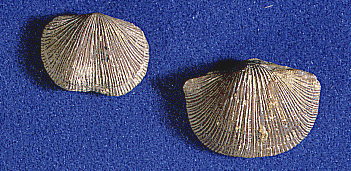
Orthid Brachiopods (Image shown with permission from
the University of California Museum of Paleontology)
Invertebrate Paleontology Lab #4
Brachiopods
Click on the lab title to see the University of
California
Museum of Paleontology web page
Read BEFORE Coming to
Lab:
Benton & Harper, Chapter 12, p. 297-313
Introduction
This week we explore the most common
macroinvertebrate
fossil group, the Brachiopod Phylum. Brachiopods are exclusively
marine, shelled invertebrates that are members of the Superphylum
Lophophorata,a
group of organisms that feed with a ciliated hollow, crown shaped
structure
called the lophophore. Other members of the
Lophophorata
are the worm-like Phoronids and the colonial Bryozoans, which
we examined last week.
Brachiopods
are
easily the most common fossil macroinvertebrate, and therefore have
tremendous
use as guide fossils, as paleoecological indicators, as sources for information
on functional morphology and phylogeny, and as sources for geochemical and
isotopic analyses. In life, they are notably characterized by
the
presence of the lophophore, as well as a pedicle (a stalk)
for anchoring to the substrate (the pedicle can be a pronounced, fleshy
structure as in the Inarticulates, or reduced to a hardly visible rough
area on the pedicle valve, as in the Articulates). As fossils, the opening
for the pedicle is often visible, and the internal structures of the shell
indicate the location of the lophophore. Although they
are not very common today, they underwent considerable diversification
in the Paleozoic, and are a subject of many phylogenetic and cladistic
studies.
The Lophophore: the distinguishing structure
found
in the Phylum Brachiopoda and also in the Phylum Bryozoa
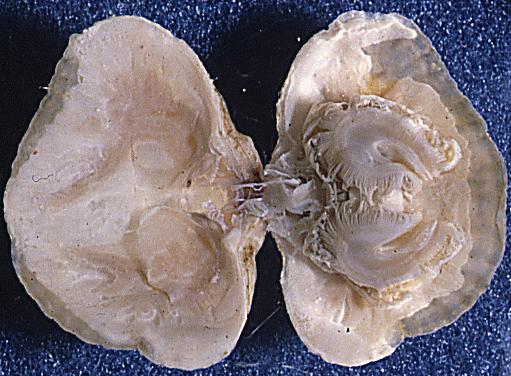
This interior view of an articulate brachiopod
clearly
shows the ciliated lophophore feeding structure, coiled in pairwise
fashion
inside the brachial (dorsal) valve.
In life, this structure extracts food particles from
the water column, and thus depends on water that has a current and is
free
of suspended sediment.
Image shown with permission from the University of
California
Museum of Paleontology
Phylum Brachiopoda, Class Inarticulata
(Cambrian-Recent)
and Class Articulata (Cambrian-Recent)
| Basic Facts & Terms to Know about Brachiopods: They
are: |
|
| 1. |
Eukaryotes |
| 2. |
Metazoans with organs, true tissues, nervous,
muscular, and
reproductive systems |
| 3. |
characterized by a Lophophore feeding
structure
for benthic filter feeding, pedicle structure for anchoring to
substrate,
and a bivalved shell |
| 4. |
Bilateral in symmetry, symmetry plane passing
vertically
through the valves |
| 5. |
free-swimming in larval stage (larvae):
sessile
(attached or burrowing)as adults |
| 6. |
able to reproduce sexually |
| 7. |
structurally supported by calcium carbonate or
calcium phosphate
shell |
| 8. |
found in marine environments, Sessile
(Attached)
or burrowing. |
| 9. |
divided into two groups based on presence of toothed
hinge in
shell: Articulata-with a toothed hinge, or Inarticulata,
without a toothed hinge structure. |
What ecological factors can you expect to be important to their
survival?
Consider the problems of substrate type, respiration, feeding, and
avoiding
predation.
Part I. Individual Assignment: Draw and
Label
4 Specimens of Brachiopoda 20 pts.
Label the Ventral (Pedicle) valve, the Dorsal
(Brachial)
valve, the beak, the sulcus, the fold, growth
lines,
and costae, as well as the Order, Genus (if provided), and time
range
for the specimen. For some specimens, you may find that you can't
label all these areas because they are not visible.
What is...
Ventral (Pedicle) valve: The larger of the two valves,
and the valve that may have an opening for the pedicle.
Dorsal (Brachial) valve: The smaller of the two valves,
and the valve that holds the calcareous support for the lophophore, the
brachidium.
Beak-the pointed portion of the ventral (pedicle) valve near
the hinge.
Sulcus-a very deep trough on one valve
Fold-a high ridge on one valve that corresponds to the sulcus
on the other valve
Growth Lines-concentric lines of continual growth of the shell
as the animal increases in size
Costae-rib-like ridges that run radially from the beak to the
edge (commissure) of the shell.
Part II. Group Assignment: A first look at Caesar's Creek Fossils - 20 pts
Each group should examine the slab(s) of fossiliferous limestone from
Caesar's Creek (Upper Ordovician) and note the presence of corals (what
order?), bryozoans (what growth habit?), brachiopods (what
order?) and sponges (what class?). Can you find examples of
these specimens, with names, in Fossils of Ohio? Record this information
on a single sheet of paper, put the names of the group members on that, and turn
it in at the end of the lab.
Notes and Images of the Brachiopoda
Class Inarticulata Range Cambrian-Recent
Order Lingulata
Genus Lingula (Cambrian-Recent)
This is a typical example of the genus
Lingula.
Lingula sp. are "living fossils", organisms that have changed very
little
since their first appearance in the fossil record (in this case, since
Cambrian time). Shown clearly here to the right of the bivalved
shell
is the pedicle, a fleshy structure that anchors the brachiopod into the
mud and permits it to live in a vertical burrow. The inarticulate
valves are opened and closed entirely with muscular support:
there
are no hinge structures beyond the muscles to aid in this.
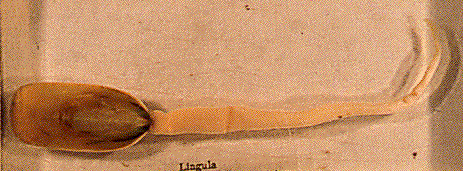
Image shown with permission from the University of California Museum
of Paleontology
Class Articulata You will find most of the fossil
brachiopods are in this Class.
Order Orthida (Cambrian-Permian)

Image shown with permission from the University of California Museum
of Paleontology
Order Strophomenida Ordovician-Triassic
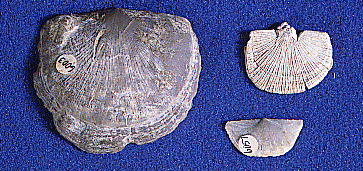
Image shown with permission from the University of California Museum
of Paleontology
Order Pentamerida (Cambrian-Devonian)
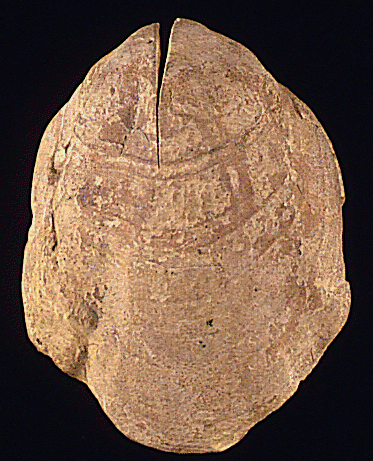
Image shown with permission from the University of California Museum
of Paleontology
Order Spiriferida (Ordovician-Jurassic)
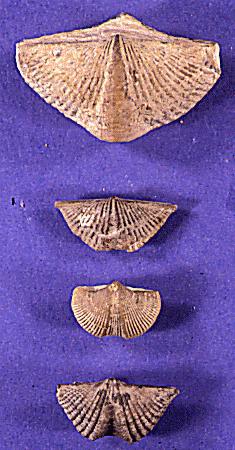
Image shown with permission from the University of California Museum
of Paleontology
Order Rhynchonellida (Ordovician-Recent)
+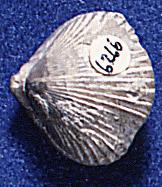
Image shown with permission from the University of California Museum
of Paleontology
Order Terabratulida (Devonian-Recent)
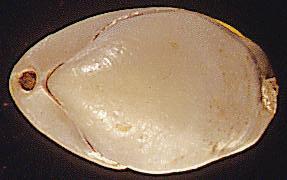
Image shown with permission from the University of California Museum
of Paleontology
Want to know more about how Brachiopods are used in geological
research?
Try these references and links
Kowalewski, M., Simoes, M.G., Carroll, M., Rodland, D.L.,
2002.
Abundant Brachiopods on a Tropical, Upwelling-Influenced Shelf
(Southeast
Brazilian Bight, South Atlantic), Palaios Volume:
17,
Issue: 3, June 1, 2002. pp. 277-286.
Craig, Robert S., 2002. The palaeobiogeography of Late
Cretaceous
and Cenozoic brachiopods from Western
Australia. Palaeogeography, Palaeoclimatology, Palaeoecology
Volume: 179, Issue: 3-4, pp. 267-292.
James, N.P.; Bone, Y.; Kyser, T.K., 1997. Brachiopod d18O
values
do reflect ambient oceanography: Lacepede Shelf, southern
Australia. Oceanographic Literature Review Volume: 44,
Issue:
12, December, 1997. pp. 1467.
Rao, C. Prasada; Huston, D., 1996. Temperate shelf carbonates
reflect mixing of distinct water masses, eastern Tasmania,
Australia. Oceanographic Literature Review Volume: 43,
Issue:
1, January, 1996. pp. 48.
Bickert, Torsten; Pätzold, Jürgen; Samtleben, Christian;
Munnecke,
Axel, 1997. Paleoenvironmental changes in the Silurian indicated
by stable isotopes in brachiopod shells from Gotland, Sweden. Geochimica
et Cosmochimica Acta Volume: 61, Issue: 13, July, 1997. pp.
2717-2730.
.
Don't forget about the Paleontology Portal, which shows images of
fossils,
including brachiopods, found in the U.S. Check out the Ohio
Brachiopods
at the Paleontology Portal here.
A nice web page on Kentucky Brachiopods...
http://www.uky.edu/KGS/coal/webfossl/pages/brachs.htm







